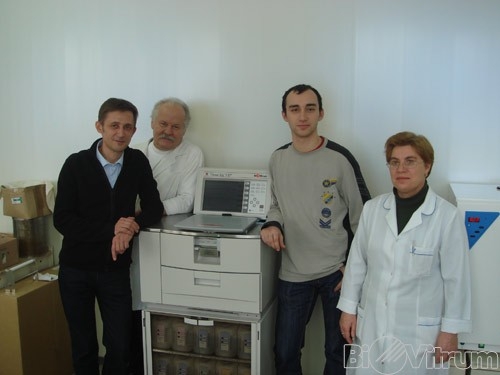
Tambov Regional Postmortem Examination Office examines over 200-250 thousand of surgical and biopsy samples annually, including approx 2,000 immunohistochemical and 4,000 histochemical studies. The samples are taken from the majority of therapy and preventive institutions (LPU) in Tambov and Tambov Region.
The total amount of patients whose samples are under study is 35,000-40,000. 17 processors AT-4 and AT-4M were used for various processing runs. The new processor replaced 15 old ones. Old processors are used only at the oncologic dispensary lab.
Experimentally the processing program has been chosen to perform efficient study of all tissue samples (incl. endobiopsy).
Here is the processing program:
1. Formalin 10% (buffered) 2 hours
2. Formalin 10% (buffered) 4 hours
1. Alcohol 70% 1 hour
2. Alcohol 1 hour
3. Alcohol 1 hour
4. Alcohol 1 hour
5. Alcohol 1 hour
6. Absolute alcohol 1 hour
1. Xylene (Toluene) 1 hour
2. Xylene (Toluene) 1 hour
1. Paraffin 45 minutes
2. Paraffin 45 minutes
3. Paraffin 45 minutes
4. Paraffin 45 minutes
As you have noticed, we do not mention alcohol strength (excluding absolute one) because after alcohol strength decreases after a processing run and the first alcohol after the formalin is diluted to approx 70%. One should take into account that for the first run alcohol reagents have ascending strength (e.g. the 1st is of 70%, the 2nd, the 3rd, the 4th are of 95%, the 6th is absolute one). After two full capacity runs we only change the 6th absolute alcohol, replace the bottles and pour out the 1st one. The other alcohol reagents are not changed and are diluted naturally. Total run time is 17 hours. The processor is being charged by 2 p.m. (incisures are made by that time). Processing run ends at 8 a.m. next day. The processor is discharged and testers take the samples to study. Specimens are ready by 1-2 p.m. So it takes one day to study the sample after the incision. It took more than 3 days to process samples in AT-4.
On Fridays (on Saturdays and Sundays tissue samples are not taken) delayed start is programmed, the processor is charged and samples are in the first formalin. The run begins at 3 p.m. on Sunday, the discharge is on Monday morning.
SAMPLES VOLUME AND REAGENT MANAGEMENT.
Not less than 200 cassettes are processed daily, each cassette containing 4-5 samples taken by a doctor. On some days the volume exceeds 300 cassettes, but the processor allows to add 50-70 cassettes more. The volume increase does not influence processing quality, as we have noticed. Reagents consumption and processing quality are influenced by plastic cassettes. Fabric napkins decrease processing quality, so considerable volumes processing is performed only with cassettes. The incisures size and thickness are to be taken into account, they should not be packed tightly into cassettes, it is advised to take more cassettes. There is a problem with marking and we do it in an old way, i.e. we put a photo paper with a lead-pencil-inscribed number into the cassette. From our experience, the inscriptions on the cassettes with various markers and pencils become unreadable after a processing run. The cassettes are nonexpendable and can be used after paraffin removal.
Taking into account the above-mentioned volumes, the reagents are changed as follows:
· Daily: the first formalin (the second dirty one replaces the first) bottle rinse water
· In a day: absolute alcohol (the first alcohol is poured out, bottles are transferred in turn)
· 4-5 days the first xylene (the second one goes to the first place)
· 5-6 days the first paraffin (the bottles are transferred, clean paraffin is placed at the end of the row)
· Monthly: alcohol and xylene in processor rinse bottles Carbon filter lifetime is longer than it is in the specifications.
ADVANTAGES AND DISADVANTAGES
ADVANTAGES
1) Considerable acceleration of samples study. The conventional histological report is issued in three days. The procedure is as follows: the 1st day – samples acceptance, the 2nd day – incision and processing, the 3rd day – specimens preparation, study, report issue. In conventional processors manual paraffin processing and preliminary fixation is necessary so the time-limit increases to 4-5 working days plus week-end. If it is urgent the processing is possible on the day of samples acceptance. The report is issued next day - the period is cut off by one day more.
2) Unauthorized access is impossible. In conventional processors the information was not secure.
3) Reagents (alcohol in the first place) consumption decrease.
For example:
17,600 tissue samples (6,000 cassettes) are processed from 12/02 to 12/03.
Alcohol consumption is 46.5 kg (2.6 g per one sample and 7,7 g per one cassette)
xylene consumption is 22.0 kg (1.2 g per one sample and 3,6 g per one cassette)
paraffin consumption is 15.5 kg (1.0 g per one sample and 2,5 g per one cassette)
In old processors total alcohol consumption would be 140 kg, xylene – 37 kg with the same samples volume. Paraffin consumption would be the same.
4) Rapid gas contamination decrease in a lab.
DISADVANTAGES
The disadvantages are extremely insignificant (e.g. no automatic timer switch to summer-time). Delayed start function is limited by 99 hours (4 days). In Russia there are long periods of public holidays (Japanese do not have such), and somebody should go to the lab to press the button in time. Immunohistochemical reactions could be influenced by long-term samples dipping into formalin during week-ends (at least, it is undesirable), but up to now we have not noticed any difference.
Best regards,
Mr. Blokhin A.V.











